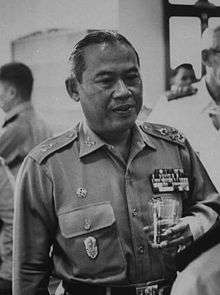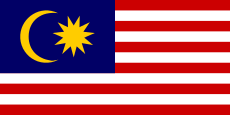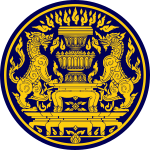Thanom Kittikachorn
| Field Marshal Thanom Kittikachorn PChW SR MPCh MWM | |
|---|---|
| ถนอม กิตติขจร | |
 | |
| 10th Prime Minister of Thailand | |
|
In office 9 December 1963 – 14 October 1973 | |
| Monarch | Bhumibol Adulyadej |
| Preceded by | Sarit Thanarat |
| Succeeded by | Sanya Dharmasakti |
|
In office 1 January 1958 – 20 October 1958 | |
| Preceded by | Pote Sarasin |
| Succeeded by | Sarit Thanarat |
| Commander in Chief of the Royal Thai Army | |
|
In office 11 December 1963 – 1 October 1964 | |
| Preceded by | Sarit Thanarat |
| Succeeded by | Praphas Charusathien |
| Personal details | |
| Born |
11 August 1911 Tak, Tak, Siam |
| Died |
16 June 2004 (aged 92) Bangkok, Thailand |
| Nationality | Thai |
| Spouse(s) | Jongkol Thanad-rob |
| Religion | Theravada Buddhism |
| Signature |
|
| Military service | |
| Service/branch | Royal Thai Army |
| Years of service | 1929–1973 |
| Rank |
|
| Commands | Supreme Commander |
| Battles/wars |
Franco-Thai War World War II |
Field Marshal Thanom Kittikachorn (Thai ถนอม กิตติขจร, Thai pronunciation: [tʰànɔ̌ːm kìttìkʰat͡ɕɔ̌ːn]; 11 August 1911 – 16 June 2004) was a military dictator of Thailand. A staunch anti-communist, Thanom oversaw a decade of military rule in Thailand from 1963 to 1973, until public protests which exploded into violence forced him to step down. His return from exile in 1976 sparked protests which led to a massacre of demonstrators, followed by a military coup.
Early life
Thanom Kittikachorn was born in Tak Province to Khun (ขุน) Sopitbannaraksa (Amphan Kittikachorn) and his wife, Mrs Linchee Kittikachorn. His family was of Thai-Chinese descent. He attended Wat Koak Plu Municipal School, then was admitted to the Army Cadet Academy. After receiving his commission, he reported for duty with Infantry Regiment VII in Chiang Mai. Thanom later studied at the Cartography School and the Infantry School, and graduated from the National Defense College in its first class.
Rise to power
After serving in the Shan States of Burma during World War II, then Lieutenant Colonel Thanom took part in a successful 1947 coup headed by Colonel Sarit Thanarat. He became a regimental commander and was head of the Lopburi military department. He was soon promoted to colonel, commanding the 11th Infantry Division. Thanom was appointed a member of parliament in 1951, his first political role. He was promoted to major general the same year.
In February 1953, Thanom led the suppression of a rebellion against military rule, and was rewarded with promotion to lieutenant general. He represented Thailand at the ceremony to mark the end of the Korean War in July 1953 and was later promoted as commander of the 1st Region Army.
He was appointed deputy cooperatives minister in 1955. Thanom supported Sarit in his coup against the government of Field Marshal Plaek Pibulsongkram, and was subsequently appointed defence minister in Pote Sarasin's puppet regime in 1957.
Thanom consolidated his power base as the 2nd military leader behind Sarit. In 1958, he was made a full general and assumed the offices of prime minister, defence minister, and army commander-in-chief. He was prime minister for nine months, when he was replaced by Sarit himself and made deputy prime minister, defence minister, and armed forces deputy supreme commander.
Prime minister
Thanom was appointed prime minister one day after Sarit's death in 1963. He subsequently appointed himself commander-in-chief of the army. One year later, he promoted himself to the concurrent ranks of field marshal, admiral of the fleet, and Marshal of the Royal Thai Air Force. Thanom continued the pro-American and anti-communist politics of his predecessor, which helped to ensure massive US economic and financial aid during the Vietnam War. Although he was personally popular, his regime was known for massive corruption. He established and led the Saha Prachathai Party in October 1968.
Thanom reappointed himself prime minister in February 1969 after general elections had been completed. The following year saw the beginnings of the 1970s peasant revolts in Thailand. Then, in November 1971, he bizarrely staged a coup against his own government, citing the need to suppress communist infiltration. He dissolved parliament and appointed himself Chairman of the National Executive Council, and served as a caretaker government for one year. In December 1972, he appointed himself prime minister for a fourth time, also serving as the defence and foreign ministers. Thanom, his son Colonel Narong, and Narong's father-in-law General Praphas Charusathien became known as the "three tyrants".
Public discontent grew, along with demands for a general election to choose a new parliament. Student-led demands for a return to constitutional government, the so-called "14 October 1973 uprising", led to three days of violence followed by the sudden downfall of his regime. Thanom and the other "tyrants" flew to exile in the United States and Singapore. Thanom's departure was followed by a restoration of a democratic rule in Thailand.
After Thammasat University massacre
In October 1976, Thanom returned to Thailand in the robes of a novice monk[1] to stay at Bangkok's Wat Bowonniwet. His return triggered student protests, which eventually moved onto the campus of Thammasat University. This was only a year after South Vietnam and Thailand's neighbours Laos and Cambodia had fallen to the communists, and right wing Thais believed the protesters wished the same fate for their country. On 6 October 1976, right wing militants, aided by government security forces, stormed the Thammasat campus, violently broke up the protests and massacred many protesters. That evening, the military seized power from the elected civilian government of Democrat MR Seni Pramoj and installed hard-line royalist Tanin Kraivixien as premier.
Thanom left the monkhood, but never again entered politics. Late in his life, he attempted to rehabilitate his tarnished image and recover properties seized when his government was overthrown.
In March 1999, Thanom was nominated to be a member of the honorary Royal Guard by Prime Minister Chuan Leekpai, which led to controversy. Thanom settled the matter by turning down the appointment.
Thanom Kittikachorn died in 2004 the age of 92 in Bangkok General Hospital, after suffering a stroke and a heart attack two years earlier. His family's medical expenses were paid by King Bhumibol Adulyadej, which some saw as payback for Thanom's agreeing to leave the country to end the violence in 1973. Thanom's cremation was held on 25 February 2007 at Wat Debsirin. Queen Sirikit presided over the cremation ceremony, lighting the royal flame on behalf of King Bhumibol. Her youngest daughter, Princess Chulabhorn, also presided. His wife died in 2012 aged 98.
Honours
Thanom received the following royal decorations in the Honours System of Thailand:[2]
- 1925 -
_ribbon.png) King Rama VII Coronation Medal
King Rama VII Coronation Medal - 1934 -
_ribbon.png) Safeguarding the Constitution Medal
Safeguarding the Constitution Medal - 1943 -
_ribbon.png) Medal for Service Rendered in the Interior
Medal for Service Rendered in the Interior - 1944 -
_ribbon.png) Chakra Mala Medal
Chakra Mala Medal - 1946 -
_ribbon.png) King Rama IX Coronation Medal
King Rama IX Coronation Medal - 1950 -
_ribbon.png) King Rama VIII Royal Cypher Medal, Third Class
King Rama VIII Royal Cypher Medal, Third Class - 1955 - Flame pin to adorn the Victory Medal - Korean War
- 1955 -
_ribbon.png) Knight Grand Cordon (Special Class) of The Most Noble Order of the Crown of Thailand
Knight Grand Cordon (Special Class) of The Most Noble Order of the Crown of Thailand - 1956 -
_ribbon.png) Knight Grand Cordon (Special Class) of the Most Exalted Order of the White Elephant
Knight Grand Cordon (Special Class) of the Most Exalted Order of the White Elephant - 1958 -
_ribbon.png) Knight Grand Commander (Second Class, higher grade) of the Most Illustrious Order of Chula Chom Klao
Knight Grand Commander (Second Class, higher grade) of the Most Illustrious Order of Chula Chom Klao - 1959 -
_ribbon.png) King Rama IX Royal Cypher Medal, Second Class
King Rama IX Royal Cypher Medal, Second Class - 1961 -
_ribbon.png) Knight Grand Cross (First Class) of The Most Illustrious Order of Chula Chom Klao
Knight Grand Cross (First Class) of The Most Illustrious Order of Chula Chom Klao - 1962 -
_ribbon.png) Border Service Medal
Border Service Medal - 1962 -
.png) Victory Medal - World War II
Victory Medal - World War II - 1964 -
_ribbon.png) King Rama IX Royal Cypher Medal, First Class
King Rama IX Royal Cypher Medal, First Class - 1965 -
 Knight Grand Commander of the Honourable Order of Rama
Knight Grand Commander of the Honourable Order of Rama - 1969 -
.png) Freeman Safeguarding Medal, First Class
Freeman Safeguarding Medal, First Class - 1972 -
_ribbon.png) Bravery Medal
Bravery Medal - 1972 -
.png) Victory Medal - Vietnam War, with flames
Victory Medal - Vietnam War, with flames - 1972 -
_ribbon.png) Red Cross Medal of Appreciation, First Class
Red Cross Medal of Appreciation, First Class
Foreign honour
-
 Malaya : Honorary Grand Commander of the Order of the Defender of the Realm (1962)[3]
Malaya : Honorary Grand Commander of the Order of the Defender of the Realm (1962)[3]
References
- ↑ In the book of exile, Thaksin pens his legacy
- ↑ Biography, Royal Thai Army website (in Thai). Retrieved on 4 December 2008.
- ↑ "Senarai Penuh Penerima Darjah Kebesaran, Bintang dan Pingat Persekutuan Tahun 1962." (PDF).
External links
| Political offices | ||
|---|---|---|
| Preceded by Pote Sarasin |
Prime Minister of Thailand 1958 |
Succeeded by Sarit Thanarat |
| Preceded by Sarit Thanarat |
Prime Minister of Thailand 1963–1973 |
Succeeded by Sanya Dharmasakti |
| Military offices | ||
| Preceded by Sarit Thanarat |
Supreme Commander of the Royal Thai Armed Forces 1963–1973 |
Succeeded by Thawee Chulasap |
| Preceded by Sarit Thanarat |
Commander-in-Chief of the Royal Thai Army 1963–1964 |
Succeeded by Praphas Charusathien |

